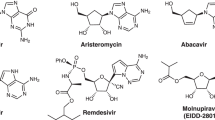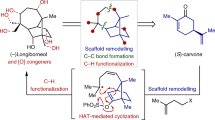Abstract
The trioxacarcins are polyoxygenated, structurally complex natural products that potently inhibit the growth of cultured human cancer cells. Here we describe syntheses of trioxacarcin A, DC-45-A1 and structural analogues by late-stage stereoselective glycosylation reactions of fully functionalized, differentially protected aglycon substrates. Key issues addressed in this work include the identification of an appropriate means to activate and protect each of the two 2-deoxysugar components, trioxacarcinose A and trioxacarcinose B, as well as a viable sequencing of the glycosidic couplings. The convergent, component-based sequence we present allows for rapid construction of structurally diverse, synthetic analogues that would be inaccessible by any other means, in amounts required to support biological evaluation. Analogues that arise from the modification of four of five modular components are assembled in 11 steps or fewer. The majority of these are found to be active in antiproliferative assays using cultured human cancer cells.
This is a preview of subscription content, access via your institution
Access options
Subscribe to this journal
Receive 12 print issues and online access
$259.00 per year
only $21.58 per issue
Buy this article
- Purchase on Springer Link
- Instant access to full article PDF
Prices may be subject to local taxes which are calculated during checkout






Similar content being viewed by others
References
Tomita, F., Tamaoki, T., Morimoto, M. & Fujimoto, K. Trioxacarcins, novel antitumor antibiotics. I. Producing organism, fermentation and biological activities. J. Antibiot. 34, 1519–1524 (1981).
Tamaoki, T., Shirahata, K., Iida, T. & Tomita, F. Trioxacarcins, novel antitumor antibiotics. II. Isolation, physicochemical properties and mode of action. J. Antibiot. 34, 1525–1530 (1981).
Shirahata, K. & Iida, T. Compounds having antibiotic activity, processes for their preparation, pharmaceutical compositions containing them and their use as medicaments. US patent 4,459,291 (1984).
Tomita, F. et al. Antibiotic substances DC-45, and their use as medicaments. US patent 4,511,560 (1985).
Maskey, R. P. et al. Anti-cancer and antibacterial trioxacarcins with high anti-malaria activity from a marine streptomycete and their absolute stereochemistry. J. Antibiot. 57, 771–779 (2004).
Maskey, R. P., Sevvana, M., Uson, I., Helmke, E. & Laatsch, H. Gutingimycin: a highly complex metabolite from a marine streptomycete. Angew. Chem. Int. Ed. 43, 1281–1283 (2004).
Pfoh, R., Laatsch, H. & Sheldrick, G. M. Crystal structure of trioxacarcin A covalently bound to DNA. Nucleic Acids Res. 36, 3508–3514 (2008).
Cassidy, J. et al. Phase I clinical study of LL-D49194α1 with retrospective pharmacokinetic investigations in mice and humans. Cancer Chemother. Pharm. 31, 395–400 (1993).
Gerber, H-P., Koehn, F. E. & Abraham, R. T. The antibody–drug conjugate: an enabling modality for natural product-based cancer therapeutics. Nat. Prod. Rep. 30, 625–639 (2013).
Švenda, J., Hill, N. & Myers, A. G. A multiply convergent platform for the synthesis of trioxacarcins. Proc. Natl Acad. Sci. USA 108, 6709–6714 (2011).
Myers, A. G., Gin, D. Y. & Rogers, D. H. Synthetic studies of the tunicamycin antibiotics. Preparation of (+)-tunicaminyluracil, (+)-tunicamycin-V, and 5′-epitunicamycin-V. J. Am. Chem. Soc. 116, 4697–4718 (1994).
Maiese, W. M. et al. LL-D49194 antibiotics, a novel family of antitumor agents: taxonomy, fermentation and biological properties. J. Antibiot. 43, 253–258 (1990).
Smaltz, D. J., Švenda, J. & Myers, A. G. Diastereoselective additions of allylmetal reagents to free and protected syn-α,β-dihydroxyketones enable efficient synthetic routes to methyl trioxacarcinoside A. Org. Lett. 14, 1812–1815 (2012).
Magauer, T. & Myers, A. G. Short and efficient synthetic route to methyl α-trioxacarcinoside B and anomerically activated derivatives. Org. Lett. 13, 5584–5587 (2011).
Mathieu, B. & Ghosez, L. N-trimethylsilyl-bis(trifluoromethanesulfonyl)imide: a better carbonyl activator than trimethylsilyl triflate. Tetrahedron Lett. 38, 5497–5500 (1997).
Kimura, Y., Suzuki, M., Matsumoto, T., Abe, R. & Terashima, S. Trimethylsilyl trifluoromethanesulfonate (trimethylsilyl triflate) as an excellent glycosidation reagent for anthracycline synthesis: simple and efficient synthesis of optically pure 4-demethoxydaunorubicin. Chem. Lett. 4, 501–504 (1984).
Kimura, Y., Suzuki, M., Matsumoto, T., Abe, R. & Terashima, S. Novel glycosidation of 4-demethoxyanthracyclinones by the use of trimethylsilyl triflate. Syntheses of optically-active 4-demethoxydaunorubicin and 4-demethoxyadriamycin. B. Chem. Soc. Jpn 59, 423–431 (1986).
Lear, M. J., Yoshimura, F. & Hirama, M. A direct and efficient α-selective glycosylation protocol for the kedarcidin sugar, L-mycarose: AgPF6 as a remarkable activator of 2-deoxythioglycosides. Angew. Chem. Int. Ed. 40, 946–949 (2001).
Ren, F., Hogan, P. C., Anderson, A. J. & Myers, A. G. Kedarcidin chromophore: synthesis of its proposed structure and evidence for a stereochemical revision. J. Am. Chem. Soc. 129, 5381–5383 (2007).
Shirahata, K., Iida, T. & Hirayama, N. Symposium on the Chemistry of Natural Products 24, 199–206 (1981).
Boyd, M. R. & Pauli, K. D. Some practical considerations and applications of the National Cancer Institute in vitro anticancer drug discovery screen. Drug. Develop. Res. 34, 91–109 (1995).
Romero, J. A. C., Tabacco, S. A. & Woerpel, K. A. Stereochemical reversal of nucleophilic substitution reactions depending upon substituent: reactions of heteroatom-substituted six-membered-ring oxocarbenium ions through pseudoaxial conformers. J. Am. Chem. Soc. 122, 168–169 (2000).
Ayala, L., Lucero, C. G., Romero, J. A. C., Tabacco, S. A. & Woerpel, K. A. Stereochemistry of nucleophilic substitution reactions depending upon substituent: evidence for electrostatic stabilization of pseudoaxial conformers of oxocarbenium ions by heteroatom substituents. J. Am. Chem. Soc. 125, 15521–15528 (2003).
Chamberland, S., Ziller, J. W. & Woerpel, K. A. Structural evidence that alkoxy substituents adopt electronically preferred pseudoaxial orientations in six-membered ring dioxocarbenium ions. J. Am. Chem. Soc. 127, 5322–5323 (2005).
Yang, M. T. & Woerpel, K. A. The effect of electrostatic interactions on conformational equilibria of multiply substituted tetrahydropyran oxocarbenium ions. J. Org. Chem. 74, 545–553 (2009).
Pedersen, C. M., Nordstrøm, L. U. & Bols, M. ‘Super armed’ glycosyl donors: conformational arming of thioglycosides by silylation. J. Am. Chem. Soc. 129, 9222–9235 (2007).
Crich, D., Hu, T. & Cai, F. Does neighboring group participation by non-vicinal esters play a role in glycosylation reactions? Effective probes for the detection of bridging intermediates J. Org. Chem. 73, 8942–8953 (2008).
Wiesner, K., Tsai, T. Y. R. & Jin, H. On cardioactive steroids. XVI. Stereoselective β-glycosylation of digitoxose: the synthesis of digitoxin. Helv. Chim. Acta 68, 300–314 (1985).
Fitzner, A., Frauendorf, H., Laatsch, H. & Diederichsen, U. Formation of gutingimycin: analytical investigation of trioxacarcin A-mediated alkylation of dsDNA. Anal. Bioanal. Chem. 390, 1139–1147 (2008).
Sun, C. et al. A robust platform for the synthesis of new tetracycline antibiotics. J. Am. Chem. Soc. 130, 17913–17927 (2008).
Acknowledgements
T.M. acknowledges the Austrian Science Fund for a Schrödinger postdoctoral fellowship (FWF J3000-B11). D.J.S. acknowledges the Department of Defense for a National Defense Science and Engineering Graduate Fellowship. Financial support from the National Institutes of Health (Grant CA047148) is acknowledged. We thank M. Shair for discussions. We thank A. Schumacher for assistance in the preparation of compounds 27 and 28, as detailed in the Supplementary Information. We acknowledge a gift of authentic samples of trioxacarcin A and DC-45-A1 from research scientists at Pfizer Research and Development in Groton, Connecticut, as well as a gift of an authentic sample of trioxacarcin A from G. Sheldrick at Universität Göttingen.
Author information
Authors and Affiliations
Contributions
T.M., D.J.S. and A.G.M. conceived the synthetic route. T.M. and D.J.S. conducted all experimental work and analysed the results. T.M., D.J.S. and A.G.M. wrote the manuscript.
Corresponding author
Ethics declarations
Competing interests
The authors declare no competing financial interests.
Supplementary information
Rights and permissions
About this article
Cite this article
Magauer, T., Smaltz, D. & Myers, A. Component-based syntheses of trioxacarcin A, DC-45-A1 and structural analogues. Nature Chem 5, 886–893 (2013). https://doi.org/10.1038/nchem.1746
Received:
Accepted:
Published:
Issue Date:
DOI: https://doi.org/10.1038/nchem.1746
This article is cited by
-
The SARP Family Regulator Txn9 and Two-Component Response Regulator Txn11 are Key Activators for Trioxacarcin Biosynthesis in Streptomyces bottropensis
Current Microbiology (2015)
-
Diversity-oriented synthesis of Lycopodium alkaloids inspired by the hidden functional group pairing pattern
Nature Communications (2014)



